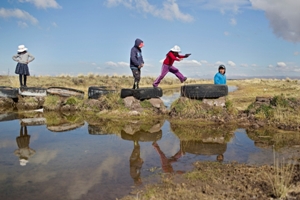DESAGUADERO, Peru — In the middle of September in 2007, a meteorite saved the people of Carancas, Peru.
When a chunk of space rock bested the atmosphere and tumbled earthward, it terrified Peruvian locals with its violent entrance of flame and smoke. At 13,000 feet, the alien mass could go no farther, and it struck the southern town of Carancas, burrowing deep into Andean soil. The impact crater, big enough to hold a school bus, burped gas and stone fragments at nearby houses before quickly filling with water.
Soon after the meteor hit, locals began showing up at the community health clinic, complaining of mysterious illnesses. Local doctors, unable to determine the causes, blamed the meteorite, and overnight, the sleepy town near the border with Bolivia became the subject of global media attention. Scientists swarmed the area to find an explanation. They interviewed residents, collected samples and studied the findings, hoping to discover microbes, electromagnetic forces or, at the very least, some foreign metals.
Instead, they found dangerously high levels of arsenic unrelated to the meteor — much of it concentrated at the town’s elementary school. For the people of Carancas, the discovery of arsenic was a devastating blow but one that may have saved their lives.
“People are dying from arsenic poisoning,” said Faruque Parvez, an environmental health scientist at the Columbia University Mailman School of Public Health who studies arsenic in Latin America. “These are the consequences for a community and an entire generation.”
An estimated 14 million people in Latin America are exposed to drinking water with unsafe levels of arsenic, making it the most widespread toxic chemical exposure in the region. Numerous studies tie the poison to a long and terrible list of serious illnesses like cancers, Type 2 diabetes, premature birth, infant mortality, heart disease, lung disease and cognitive and motor impairment for children. While an arrival from outer space alerted people to the dangers of arsenic, complications much closer to home mean they’re still not getting the help they need. The region’s poverty, corrupt officials and distrust of outsiders ensure the problem’s longevity.
News reports at the time suggested that the Carancas meteor aerosolized some arsenic-laden groundwater and that people breathing in the toxin suffered as a result. A one-time high-level exposure to arsenic could cause illness. But it’s more likely the meteor gave people the opportunity to come forward with problems they have been experiencing for years — problems caused by a lifetime of arsenic exposure, said Steven Bosiljevac, a civil engineer who has worked in Carancas.
Arsenic is so toxic that the World Health Organization says levels above 10 parts per billion in drinking water is dangerous. Ten parts per billion is tiny — the equivalent of 10 seconds in about 32 years. Yet anything more than that is enough to seriously affect health.
“If you consume even small dose of arsenic every day, your chances to get several types of cancer and other illnesses are increased,” said Dina Lopez, a hydrogeochemist at Ohio University. “It’s especially bad in the regions that are isolated, like in the countryside.”
Peru is hard hit by the arsenic issue, according to a World Health Organization (WHO) paper published last year. Out of 151 water samples taken throughout the country, more than 75 percent exceeded the recommended limit of arsenic. What’s even more frightening is that over half those samples had more than five times the limit.
“There were some serious hot spots of arsenic in groundwater,” said Heather Williams, an assistant professor at Pomona College in California who studies water politics. “A lot of it was the most toxic form.”
The meteorite put Carancas on the map. Without this oddity, a 1 in 182 trillion chance, children at the school would have spent their most formative years pouring toxins into their little bodies, Bosiljevac said.
It’s not just children who are affected, though young people are at an elevated risk because they’re still developing. Arsenic is hazardous because it mimics phosphorus, which is one of the six building blocks of life. Your body relies on phosphorus to store the energy you need to do simple things, like move an arm. When arsenic gets in your system, taking up the space once reserved for phosphorus, it can mess with your energy production and spur a host of nasty health consequences.
The negative health effects on humans are well documented, said Christine Marie George, an environmental epidemiologist at the Johns Hopkins Bloomberg School of Public Health. Leave a problem like this unchecked, she added, and entire communities could fall victim to the mental and physical disabilities caused by arsenic.


